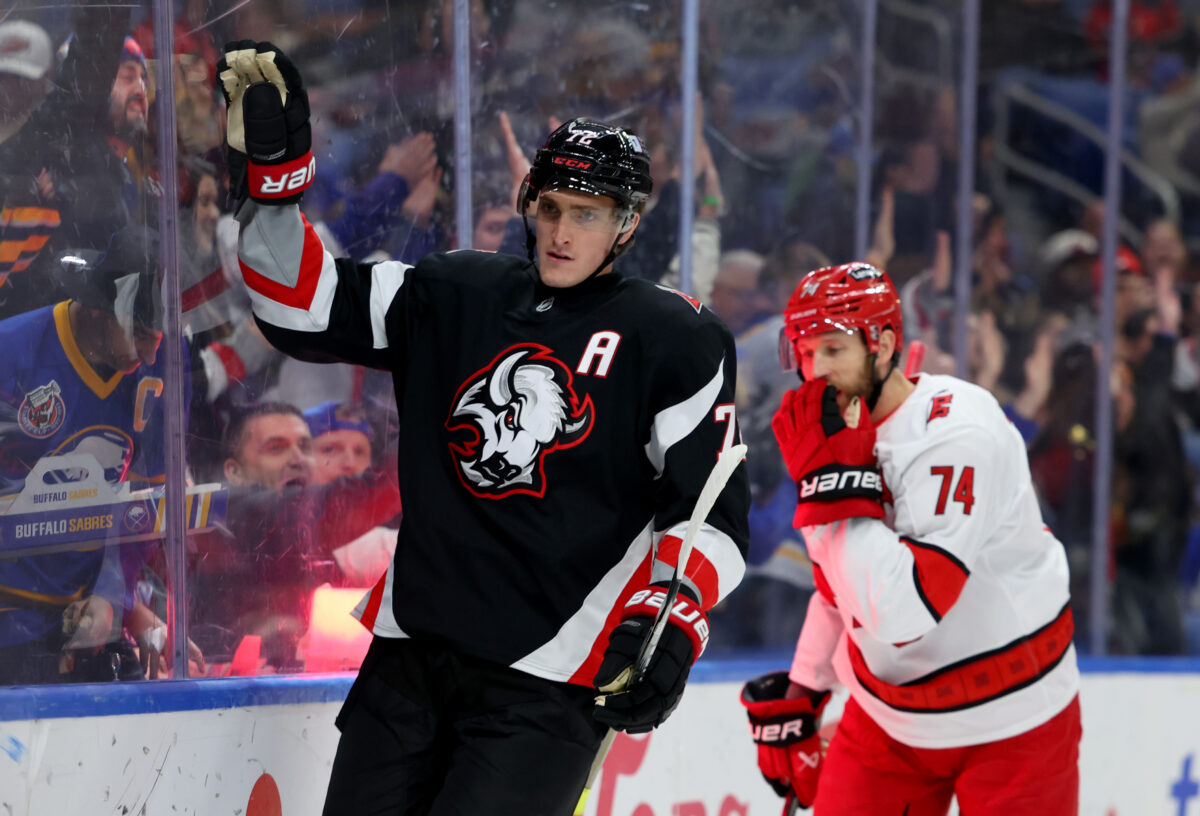The Atlantic Division has been one of the NHL’s most competitive and challenging divisions for the past few seasons, with the Tampa Bay Lightning, Florida Panthers, and Toronto Maple Leafs consistently ranking in the top half. The Boston Bruins were atop the division for many seasons before 2024-25 when they finished last. The Montreal Canadiens, Ottawa Senators, and Detroit Red Wings have been rebuilding. However, the Canadiens and Senators both made the playoffs last season and are aiming to do it again in 2025-26.
The Buffalo Sabres have missed the playoffs for a record 14 seasons and have been stuck at the bottom of the standings for much of that time. They have the young talent to compete for a playoff spot, but they have also failed to build around their core pieces and develop some important players.
The Atlantic Division did not get significantly more competitive this offseason, but the Sabres have stayed about the same. They upgraded their blue line, but it took trading a 23-year-old, 60+ point player J.J. Peterka. If Buffalo wants to compete in the Atlantic this season, the organization will have to rely on internal talent/potential over signing free agents or making trades. But as of now, how do they stack up against their division rivals?
Sabres’ Forward Group
One of the strongest units in the NHL last season, the Sabres’ forward group will be looking to continue their dominance this season. They ranked in the top 10 in goals per game, but had one of the worst power plays in the league. If the power play improves from a not-so-great 18.8% clip last season (24th in the NHL) and they continue their strong play at even strength, the team could end up in the top-five in goals per game in 2025-26.

That said, realistically, seven of eight teams in the division could finish within the top 15-20 in goals for per game, with the Bruins on the outside of that group. I think the Bruins will have another very disappointing season. Outside of David Pastrnak, they don’t have much scoring.
However, within the rest of the division, I would take the Maple Leafs’ forward group over the Sabres’ (even though they lost Mitch Marner in a sign-and-trade with the Vegas Golden Knights). They replaced Marner with some great depth additions, and Auston Matthews will likely score 50 goals again. The Lightning, one of the highest-scoring teams in the league last season, has a really strong top six. The Panthers are arguably the deepest team in the NHL upfront, including (arguably) the best two-way center in the league in Aleksander Barkov.
After those three teams, it’s up in the air between the Sabres, Senators, and Canadiens. However, I would argue that the Sabres have the fourth-best forward group in the division. It’s deeper than the Canadiens and Senators. The only thing the Senators have on the Sabres is center depth, but if center Josh Norris can stay healthy, the Sabres have a case, too. As for the Canadiens, they have some star power in the top-six, but after that, the drop-off in skill level is significant. My final rankings for forward groups in the Atlantic Division are as follows:
- 1.) Florida Panthers
- 2.) Toronto Maple Leafs
- 3.) Tampa Bay Lightning
- 4.) Buffalo Sabres
- 5.) Ottawa Senators
- 6.) Montreal Canadiens
- 7.) Detroit Red Wings
- 8.) Boston Bruins
If everything goes right this season, the Sabres could jump up to the third spot at some point. However, right now, I trust the Lightning’s forward group over the Sabres’.
Atlantic Division Defense
The Sabres’ blue line on paper got better this offseason after they acquired Michael Kesselring as part of the Peterka trade. Now the top-four consists of Rasmus Dahlin, Owen Power, Bowen Byram (fresh off a new two-year contract worth $6.5 million per season).
Related: Which Sabres Offseason Acquisition Will Have the Biggest Impact?
That group stacks up pretty well against the rest of the Atlantic. Outside of the Panthers and Maple Leafs, who have the top-two blue lines in the division, you can make an argument for the Sabres, Senators, and Canadiens at third. All three teams improved their defense this summer. Along with the Sabres acquiring Kesselring, the Senators traded for Jordan Spence from the Los Angeles Kings, and the Canadiens traded for Noah Dobson from the New York Islanders.
Overall, I give the edge to the Sabres. They have a top-five defenseman in the league in Dahlin, and a blueliner with all the potential in the world in Power. Byram is a Stanley Cup champion and can be a 50-point player in his prime, and Kesselring who is one of the better young shutdown defenders in the league.

Outside of Dobson and Lane Hutson, the Canadiens’ defense does not stand out. Kaiden Guhle is a nice young player, but is still working on his development. Mike Matheson is a solid top-four defenseman, but on some teams, he’d be on the third pairing.
My final rankings for defense in the Atlantic Division are as follows:
- 1.) Florida Panthers
- 2.) Toronto Maple Leafs
- 3.) Buffalo Sabres
- 4.) Ottawa Senators
- 5.) Montreal Canadiens
- 6.) Tampa Bay Lightning
- 7.) Boston Bruins
- 8.) Detroit Red Wings
The Senators have a very promising group of defensemen, and if I could have a 3A and a 3B on the ranking, the Sabres and Senators would be in those spots. As for the rest of the list, it might be a hot take to have the Lightning in the sixth spot, but outside of Victor Hedman, their blue line is pretty weak.
It’s the same situation with the Red Wings and Bruins; they have one borderline elite defenseman, but the rest of their group is not great. The only difference between the three teams is that the Lightning have serviceable players on their blue line, whereas the Bruins and Red Wings have a significant drop-off after their top pairing.
Sabres’ Goaltending Tandem
Goaltending is the weakest part of the Sabres’ roster. Ukko-Pekka Luukkonen is a serviceable goaltender but struggled a lot last season. Posting a save percentage (SV%) of .887 and a goals-against average (GAA) of 3.20. Buffalo acquired Alex Lyon in free agency as the backup for this season. This tandem doesn’t compare to the rest of the division.
With the acquisition of John Gibson, the Red Wings’ goaltending got a lot better. The Canadiens have Sam Montembeault and Jakub Dobes, who were phenomenal at the end of last season. The Maple Leafs, with Anthony Stolarz and Joseph Woll, have a stellar tandem. It’s hard for the Sabres to compete when the other teams in the division blow theirs out of the water.
My final rankings for goaltending tandems in the Atlantic Division are as follows:
- 1.) Toronto Maple Leafs
- 2.) Montreal Canadiens
- 3.) Detroit Red Wings
- 4.) Tampa Bay Lightning
- 5.) Ottawa Senators
- 6.) Florida Panthers
- 7.) Buffalo Sabres
- 8.) Boston Bruins
This list might be a little controversial, but the Panthers’ tandem of Sergei Bobrovsky and Daniil Tarasov is good but not great, and Tarasov is an unproven goaltender they acquired from the Columbus Blue Jackets in a trade this offseason. The Senators could easily jump up to the third or fourth spot if Levi Merilainen performs as the team expects him to. Of course, as a 22-year-old goaltender, I’m not expecting him to light the world on fire, but a SV% over .900 and a GAA of under 3.00 would be ideal.
Overall, the Sabres stack up pretty well against their division rivals heading into the season, at least on paper. The main concern will be maximizing their talent. Will Byram and Power be better this season? Can Luukkonen bounce back? Will trading Peterka hurt the offense that badly? There are questions surrounding the team, but if they can answer most of them early in the season, there’s no doubt they can compete in the Atlantic Division.
